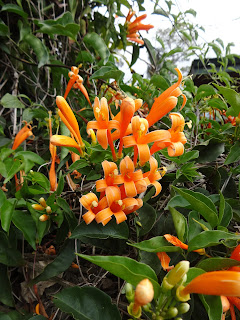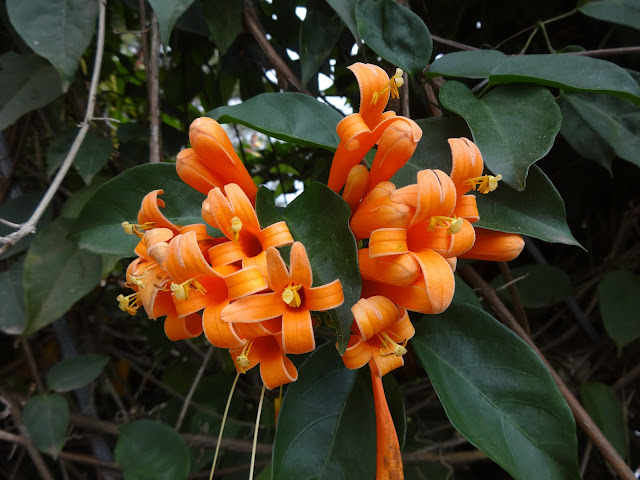
PLANT PROFILE
Pyrostegia venusta is tropical perennial vine native to South and Central America. It grows wild in areas from Argentina to Mexico, and is wildly cultivated for beauty of it's flowers in gardens in tropical and subtropical regions on other continents. Although it is very popular as an ornamental plant in many countries around the world, it is mostly unknown as a herb. But Pyrostegia venusta is commonly used in traditional medicine of Brasil for treatment of infections of respiratory system like colds, flu and bronchitis, stomach complains and skin diseases, and tea made from its leaves and flowers is drunk as general tonic. Unfortunatelly very little details about it's uses can be found written in English. But those scarce informations about medicinal values of P. venusta, have brought to it attention of some scientists, and number of pharmacological and medicinal studies on it is growing.
Pyrostegia venusta is known in many countries by its English common names like : Flame Flower, Golden Shower, Orange Shower, St. John Vine, Flame Vine, Flaming Trumpet, Fire-cracker Vine and Orange Bignonia.
But this plant has also many locally used names coming from many other languages, like : Cipo de Sao Joao, Cipo Caititu, Cipo Tinga, Dedo de Moca (Brasil), Pico de Tucan, Flor de San Juan (Argentina), Lluvia de Oro (Peru), Chiltote, Chorro de Oro, Chorro (Guatemala), San Carlos (El Salvador), Triquitraque (Costa Rica), Yvyrati (Paraguay), Pao Zhang Hua (China), Huapala (Hawaii), Liane aurore, Liane de feu (French), Feuerranke (German), Tulitrumpetti (Finnish), Flamranka (Swedish), Tanga pu (Tamil), Sankrant Vel (Marathi), Talupite ulo (Tongan).
Pyrostegia venusta is sometimes still called Pyrostegia ignea, and also has many out of use botanical synonymes like Bignonia ignea, Bignonia tubulosa, Bignonia venusta, Jacaranda echinata, Pyrostegia amabilis, Pyrostegia dichotoma, Pyrostegia ornata, Tecoma venusta and more.

CULTIVATION AND HARVESTING
Pyrostegia venusta is a perennial, evergreen vine that comes from tropical and subtropical regions of South and Central America. It is widely spread in open fields, shrublands, edges of forests and coastal areas, and is often planted in gardens. It climbs or creeps at fast rate, with length range of around 12m. It likes slightly acidic soil but tolerate neutral, slightly alkaline or saline conditions. It grows and flowers best in full sunlight. It doesn't flower well in hot and humid conditions, but it is all covered in bloom for long time when season is dry and temperatures are cooler. If your plants don't produce many flowers, pruning might help. It is also important not to overfeed Pyrostegia. In very fertile and moist soil it will grow rapidly, but you won't see many flowers on it, if any, even during the peak of it's flowering season. It copes well with extreme heat and can survive slight frost. In regions with cold winters it can be grown as a pot plant.
If you have access to the plant at all time, I dont see any reason why you should dry and storage it. I don't have informations that would confirm this, but i think that just like most of herbs Pyrostegia is best to be used fresh whenever possible. Plus, why to make a fuss with drying it, if the teas from it's fresh or dried leaves and flowers taste nearly the same. Of course you might want to gather and dry some flowers to storage for later, as it might not appear for long in your region (in some places it is in bloom for half a year or nearly whole year round). Chinese says that leaves and flowers of Pyrostegia can be sun dried, but I always prefer to dry those parts of herbs in shade, as some bioactive substances are getting damaged by strong sun rays exposure.
 CULINARY USES
CULINARY USESInfusions made from leaves and flowers of Pyrostegia venusta are one of those herbal infusions that I like to drink for no therapeutic reason, but just for pure pleasure of it. I've picked it first from my friend's garden in the Philippines, after I've found an information that Pyrostegia's infusions are drunk as a tonic in Brasil. First I've tried infusion from fresh, chopped flowers and leaves, and I couldn't descirbe the mild taste of this tea. But the words that have come to my mind was - that this a Feel Good Tea. So I was not surprised later, when during deep research on this herb, I've found information that it is used also as a antidepressant.
I didn't found much difference in taste of infusions from separate fresh leaves and fresh flowers, and those made from dried flowers and separate dried leaves. Exception is that the tea from dried leaves is a bit more bitter than all the other. Still though I've found this bitterness to be barely noticeable and so I think that this is a good tea for all the people that don't like bitter drinks.
MEDICINAL USES
It is hard to find anywhere any information about medicinal use of Pyrostegia venusta. Nearly every information about it's traditional use as a healing herb comes from Brasil. Where it's aerial parts but also roots was reported to be used by native people in form of decoctions or infusions, for the treatment of :
- respiratory system infections and inflammatory diseases like cough, cold, flu, bronchitis
- diarrhoea, dysentery and jaundice,
- infections and white patches on the skin, like erysipelas, vitiligo and leucoderma (mostly flowers taken)
- uterine and genital tract infections in women and female newborn
- it is also drunk as a general tonic and used as an antidepressant
- it is said to treat any inflammatory disease
- flower preparations have been shown to attenuate vomiting
I've found just one report from China (from Hong Kong Baptist University), and it states that : Pyrostegia venusta's flowers and leaves known in Chinese medicine as Pao Zhang Hua, are harvested in spring and summer, and sun-dried. The flowers are described as sweet in taste and neutral in nature (which means that it neither acts warming nor cooling on the body), while leaves as bitter in taste, little harsh, and neutral in nature. It is said to moistening the lung for suppressing cough, clearing heat for disinhibiting the throat, and is used for tuberculosis, lingering cough, swelling pain of throat. Taken orally in form of decoction - 10-15g, or powder - 3g each time, taken with warm boiled water.
I didn't found any information about external use of infusions, decoctions, or poultice from crushed flowers and leaves of P. venusta. But i guess it might be effective if applied on skin infections and inflammations.
There is still not many scientific studies that have been made on medicinal and pharmacological properties of Pyrostegia venusta. Most of it was conducted in Brasil, but some also in other countries like India and Egipt.
This herb's medicinal actions are described as : antidiarrheal, antioxidative, antiinflammatory, antitumor (melanoma), anthelmintic, antinociceptive, antimicrobial, antifungal, immunomodulatory and antidepressive. It increase wound contraction, tensile strength, hydroxyproline, hexosamine and cytokine content - which suggest its use as a vulnerary agent, and stimulate melanogenesis.
Its leaves contain : flavonoids, sitosterol, rutin, n-hentriacontan, acacetin-7-O- -D-glicopyranoside, mesoinositol, stigmasterol, allantoin, terpenes (amyrin and oleanolic acid), alkaloids, tannins
Flowers : myoinositol, allantoin, dotriacontane, hexadecanoic acid, linoleic acid, oleic acid, stigmasteryl tosylate, diazoprogesterone, arabipyranose, propanoic acid, pentamethyldisilanyl ester, acetophenone, trans-3-hexenedioic acid, 9-octadecenoic acid (Z)-methyl ester, amino acids, phenylpropanoid glycosides (verbascoside and isoverbascoside), lutein, b-carotene, b-cryptoxanthin, violaxanthin, zeaxanthin, b-sitosterol, n-hentriacontane(n-C31H64), 7-O-b-D-glycopyranosylacacetin, D-myo-inositol, stigmasterol, b-amyrin and oleanolic acid
Stem bark : lupeol, betulin, betulinic acid and choline chloride
Roots : allantoin, steroids, hesperidin and 3-b-b-D-glicopiranosil, sitosterol, b-sitosterol
Flowers extract of Pyrostegia venusta exhibited moderate antimicrobial activity against: Bacillus subtilis, Staphylococcus epidermidis, Staphylococcus pyogenes, Staphylococcus aureus, Escherichia coli, Micrococcus luteus, Enterobacter aerogenes, Salmonella typhi, Pseudomonas aeruginosa, Candida albicans, Aspergillus niger and Candida tropicana.
Research showed that both the leaves and flowers extracts of Pyrostegia venusta stimulates cellular melanogenesis (B16F10) at very low concentrations. Which support the folk medicinal use of this herb in treatment of hypopigmentation diseases, such as vitiligo and leucoderma.
The results of other study suggest that P. venusta might by useful anticancer agent against epidermal and slowly invasive melanomas (such as acral lentiginous melanoma).
Sources
Pyrostegia venusta (Ker Gawl.) Miers: A Botanical, Pharmacological and Phytochemical Review -
Nada M Mostafa, Omayma El-Dahshan and Abdel Nasser B Singab, Department of Pharmacognosy, Faculty of Pharmacy, Ain Shams University, Abbassia, Cairo, Egypt
EXTRACTION OF ANTIOXIDANT FROM SOME BRAZILIAN PLANTS - Priscilla C. Veggi, Diego T. Santos, M. Angela A. Meireles* LASEFI/DEA/FEA (School of Food Engineering)/UNICAMP (University of Campinas), Rua Monteiro Lobato, Brazil
Pyrostegia venusta heptane extract containing saturated aliphatic hydrocarbons induces apoptosis on B16F10-Nex2 melanoma cells and displays antitumor activity in vivo - Carlos R. Figueiredo, Alisson L. Matsuo, Felipe V. Pereira, Aline N. Rabaça, Camyla F. Farias, Nátalia Girola, Mariana H. Massaoka, Ricardo A. Azevedo, Jorge A.B. Scutti, Denise C. Arruda, Luciana P. Silva,1 Elaine G. Rodrigues, João Henrique G. Lago,2 Luiz R. Travassos, and Regildo M.G. Silva1
Pre-clinical evidences of Pyrostegia venusta in the treatment of vitiligo. - Moreira CG, Carrenho LZ, Pawloski PL, Soley BS, Cabrini DA, Otuki MF.
Anti-inflammatory and antinociceptive effects of the hydroethanolic extract of the flowers of Pyrostegia venusta in mice - Clarice C. Veloso; Layla D. M. Cabral; Andressa D. Bitencourt; Lidiane S. Franqui; Flávia V. Santa-Cecília; Danielle F. Dias; Roseli Soncini; Fabiana C. Vilela; Alexandre Giusti-Paiva
Pyrostegia venusta (Ker Gawl.) Miers Crude Extract and Fractions: Prevention of Dental Biofilm Formation and Immunomodulatory Capacity - Mayara Brito de Sousa, José Otávio Carrera Silva Júnior, Wagner Luiz Ramos Barbosa, Erika da Silva Valério, Andriele da Mata Lima, Marlon Heggdorne de Araújo, Michelle Frazão Muzitano, Celso Vataru Nakamura, João Carlos Palazzo de Mello, and Francisco Martins Teixeira1,
Hydroethanolic extract of Pyrostegia venusta (Ker Gawl.) Miers flowers improves inflammatory and metabolic dysfunction induced by high-refined carbohydrate diet - Clarice de Carvalho Velosoa, Marina Chaves de Oliveirab, Cristina da Costa Oliveiraa, Vanessa Gregório Rodriguesd, Alexandre Giusti-Paivae, Mauro Martins Teixeirab, Igor Dimitri Duartea
Pyrostegia venusta attenuate the sickness behavior induced by lipopolysaccharide in mice - Clarice C. Velosoa, Andressa D. Bitencourta, Layla D.M. Cabrala, Lidiane S. Franquia, Danielle F. Diasb, Marcelo H. dos Santosb, Roseli Soncinia, Alexandre Giusti-Paiva
Preliminary study of the antioxidant properties of flowers and roots of Pyrostegia venusta (Ker Gawl) Miers - Purabi Roy, Sarika Amdekar, Avnish Kumar and Vinod Singh
Evaluation of anticandidal and antioxidant activities of phenolic compounds from Pyrostegia venusta (Ker Gawl.) Miers - Ana Maria S. Pereira, Camila Hernandes, Sarazete I.V. Pereira, Bianca W. Bertoni, Suzelei C. França,Paulo S. Pereira, Silvia H. Taleb-Contin
Hyperpigmentant activity of leaves and flowers extracts of Pyrostegia venusta on murine B16F10 melanoma - Camila G. Moreira, Cintia D.S. Horinouchi, Claudio S. Souza-Filho, Francinete R. Campos, Andersson Barison, Daniela A. Cabrini, Michel F. Otuki,
In vitro germination, callus induction and phenolic compounds contents from Pyrostegia venusta (Ker Gawl.) Miers - Karina de Queiroz Braga, Mairon César Coimbra and Ana Hortência Fonsêca Castro
NÚMERO CROMOSSÔMICO DE ERVA-DE-SÃO-JOÃO (Pyrostegia venusta KER-GAWL.) MIERS - BIGNONIACEAE - Fabrícia Barcelos de Souza; Isane Vera Karsburg
http://libproject.hkbu.edu.hk/was40/detail?lang=en&channelid=1288&searchword=herb_id=D01293
http://medplants.blogspot.com/2014/11/pyrostegia-venusta-flame-vine.html
http://www.indiaplants.com/plant-details.php?x=DWgSF5b/xw4=
http://www.stuartxchange.org/FlameFlower.html





















































